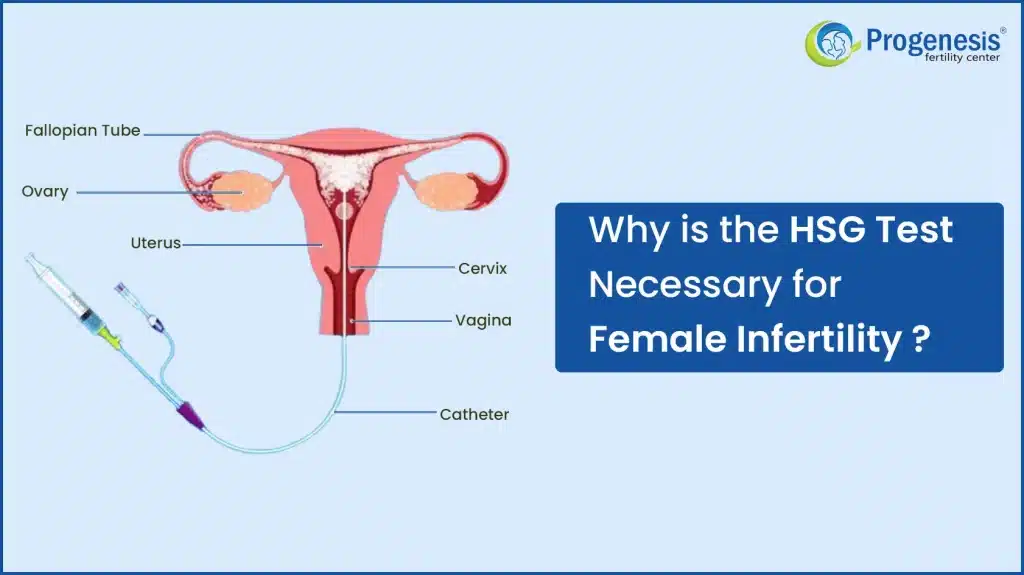Infertility is a disease in males and females that prevent a couple from getting pregnant naturally. Tubal factors contribute to about 40% of female infertility. Such tubal factors must be necessarily examined and treated in order to be able to conceive.
A hysterosalpingogram (HSG) test is done to examine the uterus and fallopian tubes. A radio-opaque substance, frequently a dye, is placed into the cervical canal, which leaks into the abdominal cavity to thoroughly examine the structure of the fallopian tubes and uterine cavity.
How does HSG help?
The HSG procedure can be used to diagnose Asherman’s syndrome, pelvic inflammatory disease and tubal blockage.
The fallopian tube test helps in finding out if the tubes are obstructed. You cannot become pregnant if the fallopian tube is blocked in some way that prevents the sperm from fertilizing the egg. An ectopic pregnancy could also result from a partially obstructed tube.
When should one get an HSG test done?
The hysterosalpingogram is one of the initial tests advised in the following circumstances:
- If you’re experiencing difficulties getting pregnant
- If you’ve gone through more than two miscarriages
- To look for tubal blockages
- To check for an irregularly formed uterus
Note: An HSG shouldn’t be performed if you’re pregnant or if you have a pelvic infection.
Having trouble conceiving? Contact us for through diagnosis and expert fertility treatments.
Free consultationHSG test procedure
The HSG procedure can be carried out using an x-ray imager called fluoroscope, at the clinic of your gynecologist. Your doctor will enter a speculum, clean the cervix, and then introduce a tiny tube called a cannula. The speculum will then be removed so that your doctor may obtain x-ray images after the uterus has been filled with an iodine-containing liquid. The fallopian tubes and uterus will contrast with the dye, revealing their outline and the flow of fluid through them.
- HSG is performed between days 1 and 14 of the first part of your cycle.
- The surgery itself only takes around five minutes.
- You may receive painkillers and an antibiotic to lower the risk of infection
- After reviewing the HSG scan images, a radiologist will send your doctor a detailed report.
How to get pregnant after HSG?
If the results of your HSG indicate that you are unable to carry out a natural conception, there are still plenty of options for you to help start your family. ART treatments, for instance, are a very effective method of fertility treatments that can tackle infertility and help you in getting pregnant.
- If you are having trouble getting pregnant naturally, your doctor might advise ovarian stimulation or IUI combined with ovarian stimulation.
- Medical intervention will be required if both tubes are impacted in order to become pregnant. Laparoscopy and hysteroscopy are further treatments for obstructed fallopian tubes.
- Despite even severe tubal patency, IVF treatment is incredibly effective in establishing pregnancy since it entirely avoids the fallopian tubes.
In an IVF process, your fertility specialist removes the mature egg and fertilizes it in an IVF lab with the sperm. The resultant embryo is then immediately placed into the uterine lining. You can avoid the fallopian tube’s function with IVF treatment and yet become pregnant.
Benefits of HSG Test
The HSG test has the following advantages:
- It can detect uterine abnormalities such as polyps, fibroids, and congenital defects.
- It can evaluate the fallopian tubes’ functionality and spot any obstructions that might prevent conception.
- The test is less invasive than some other procedures and is used as the initial step in the diagnosis of infertility.
Understand how to deal with fertility problems? get expert guidance from fertility specialists
Free consultationFAQ’s
What is the HSG test full form?
The X-ray procedure known as hysterosalpingography, or HSG, is used to identify the internal structure of the uterus and determine whether the fallopian tubes are blocked.
What is the reason for HSG test?
The uterus and fallopian tubes can be seen on X-ray through the hysterosalpingography (HSG) procedure . It is frequently used to determine whether the fallopian tubes are completely or partially blocked. Additionally, it might reveal whether the uterus’ inside is regular in size and form.
When is the best time to do HSG test?
It is ideal to have HSG performed from days 1 to 14 of the menstrual cycle.
Can I get pregnant immediately after HSG?
Depending on the cause of your infertility and the type of contrast the technician uses, you may be more likely to become pregnant in the three months following an HSG. HSG’s are requested by doctors for diagnostic purposes.
Is HSG test painful?
When your doctor inserts the dye solution into your uterus, you can experience cramping.

